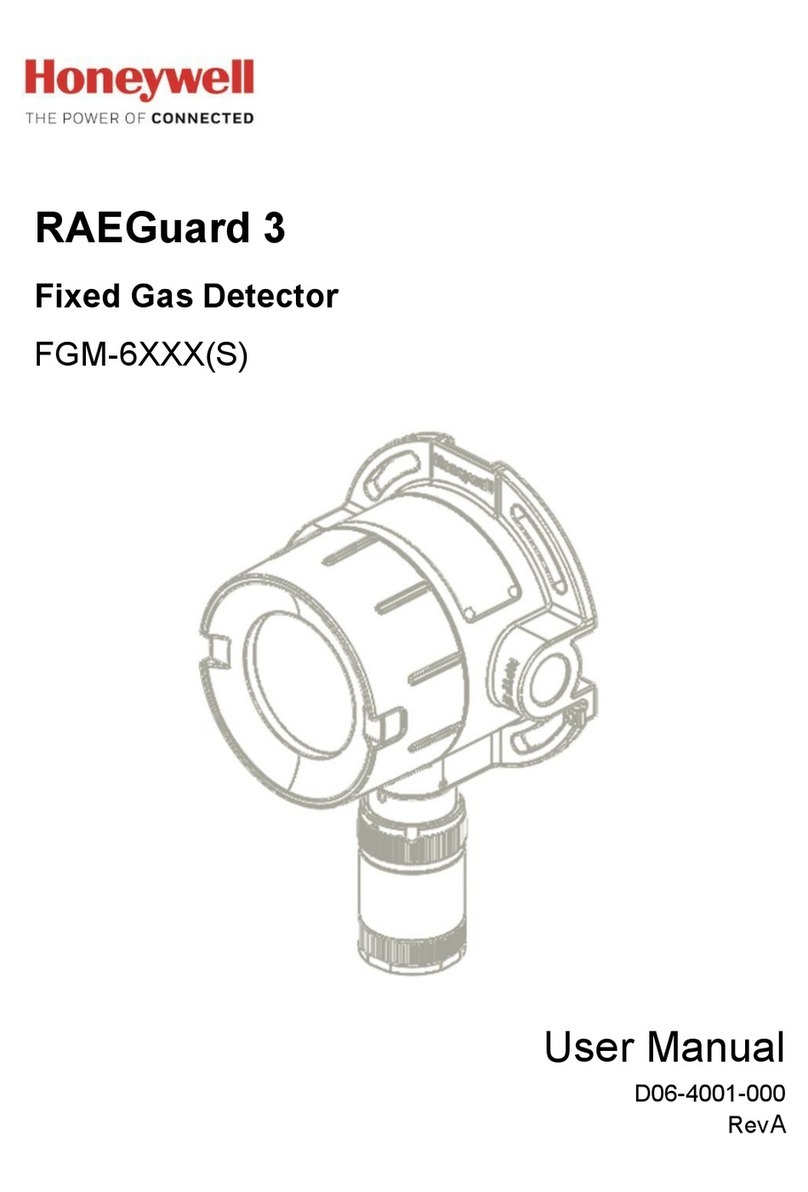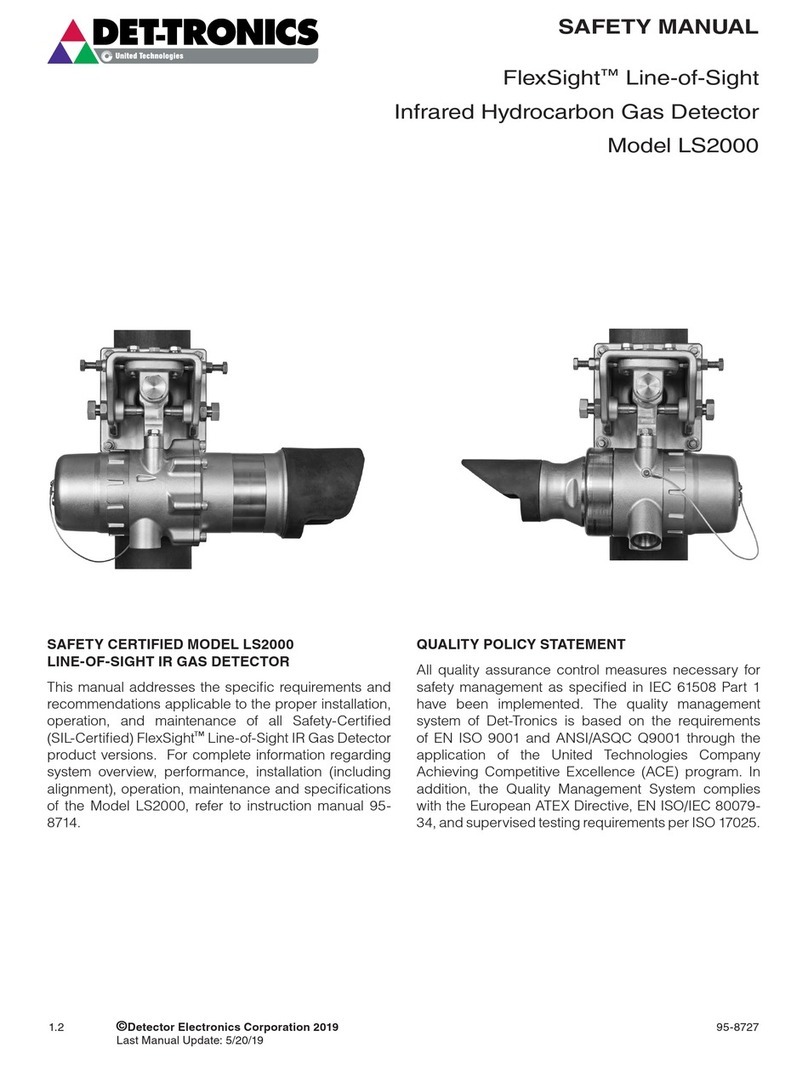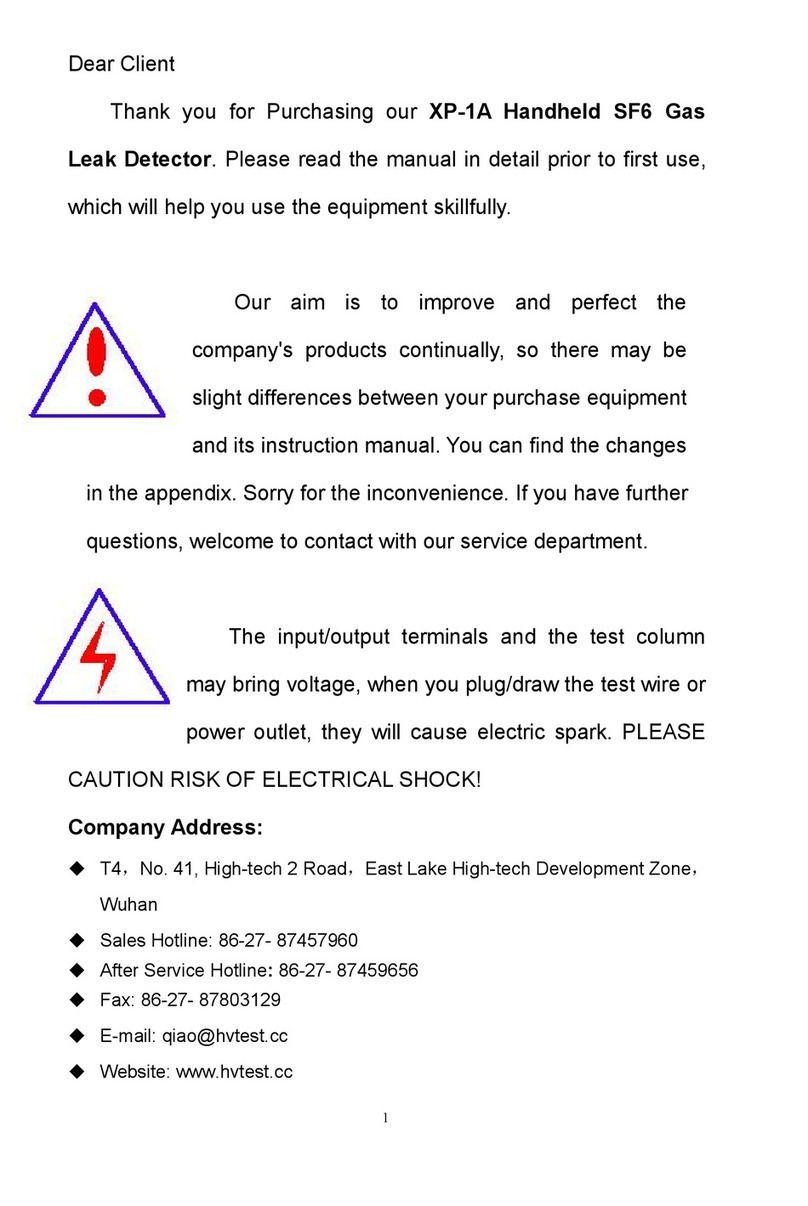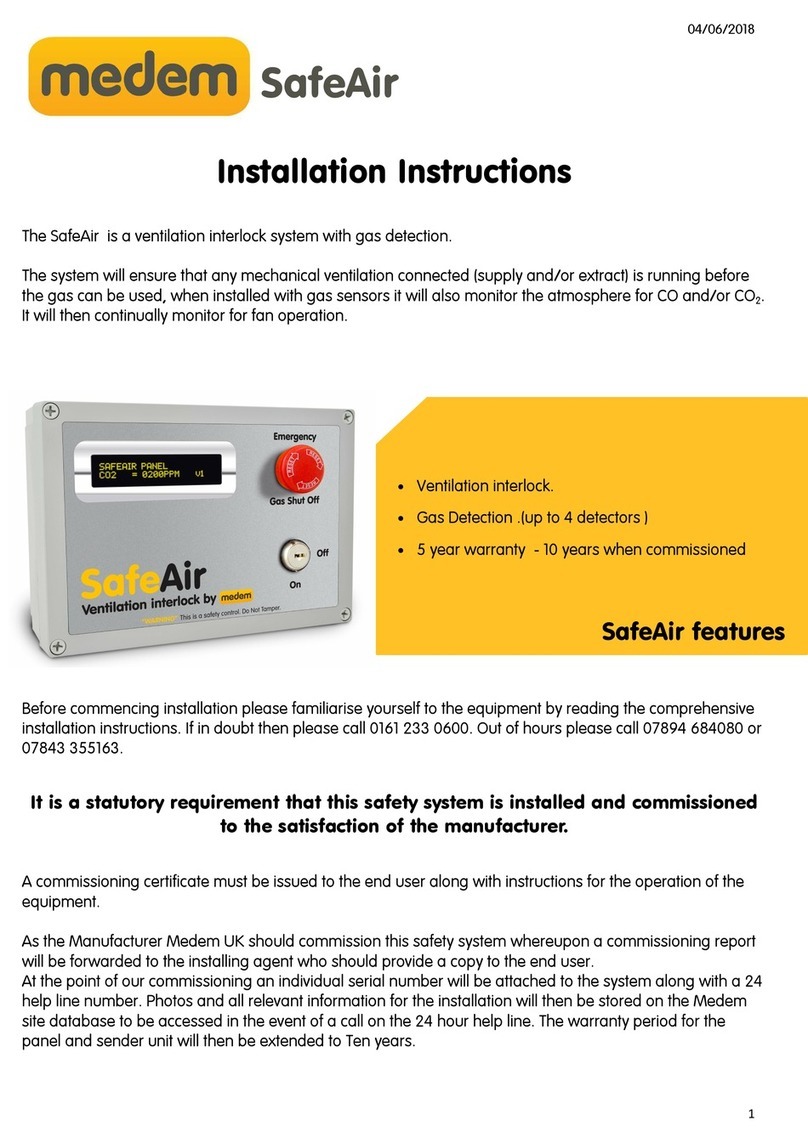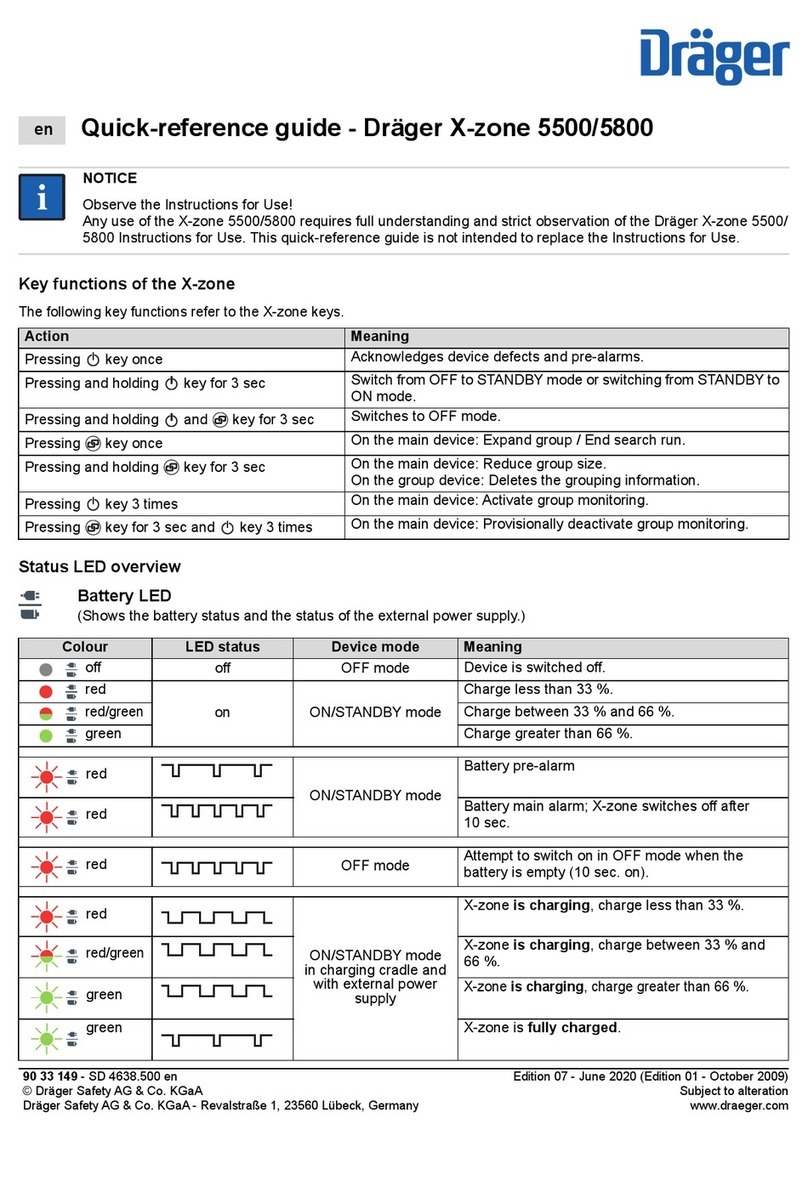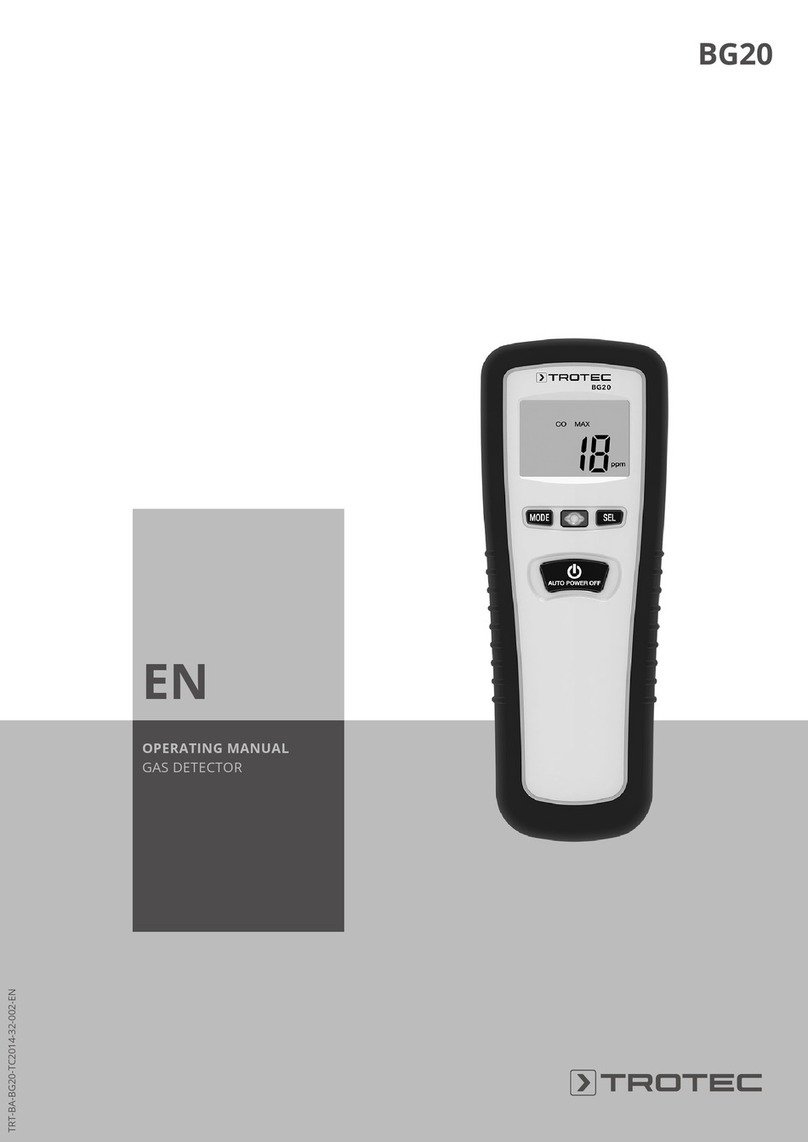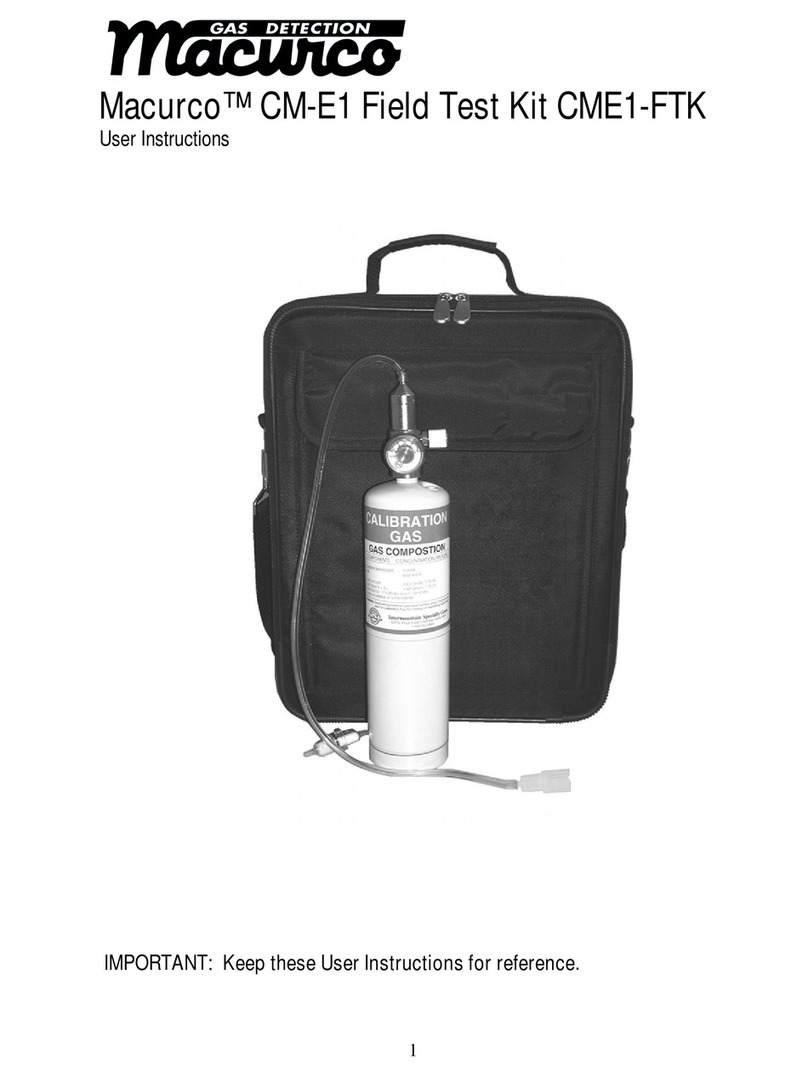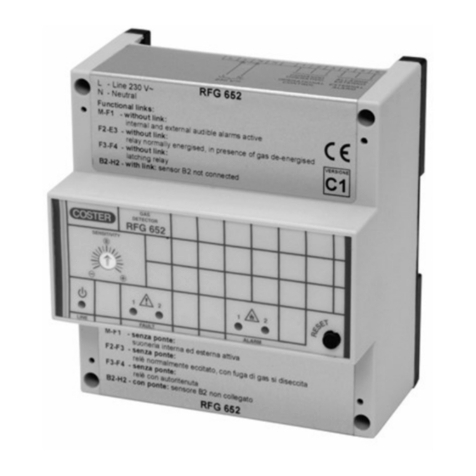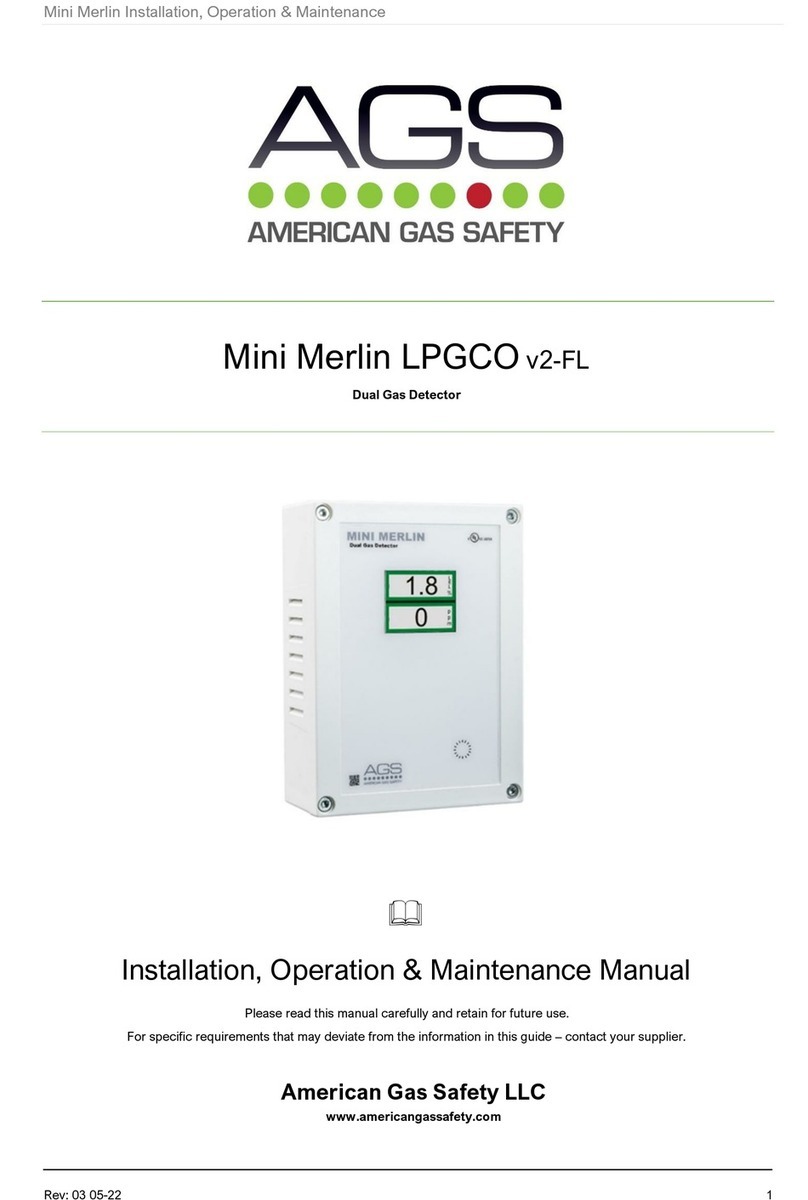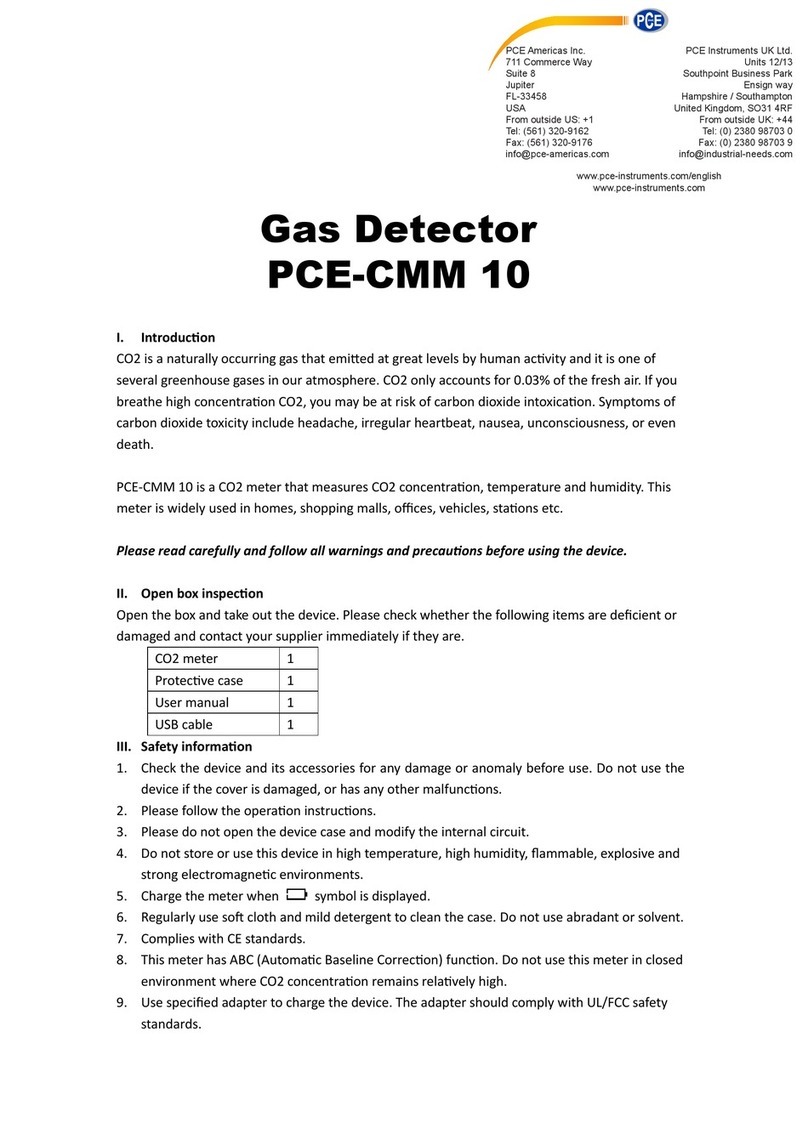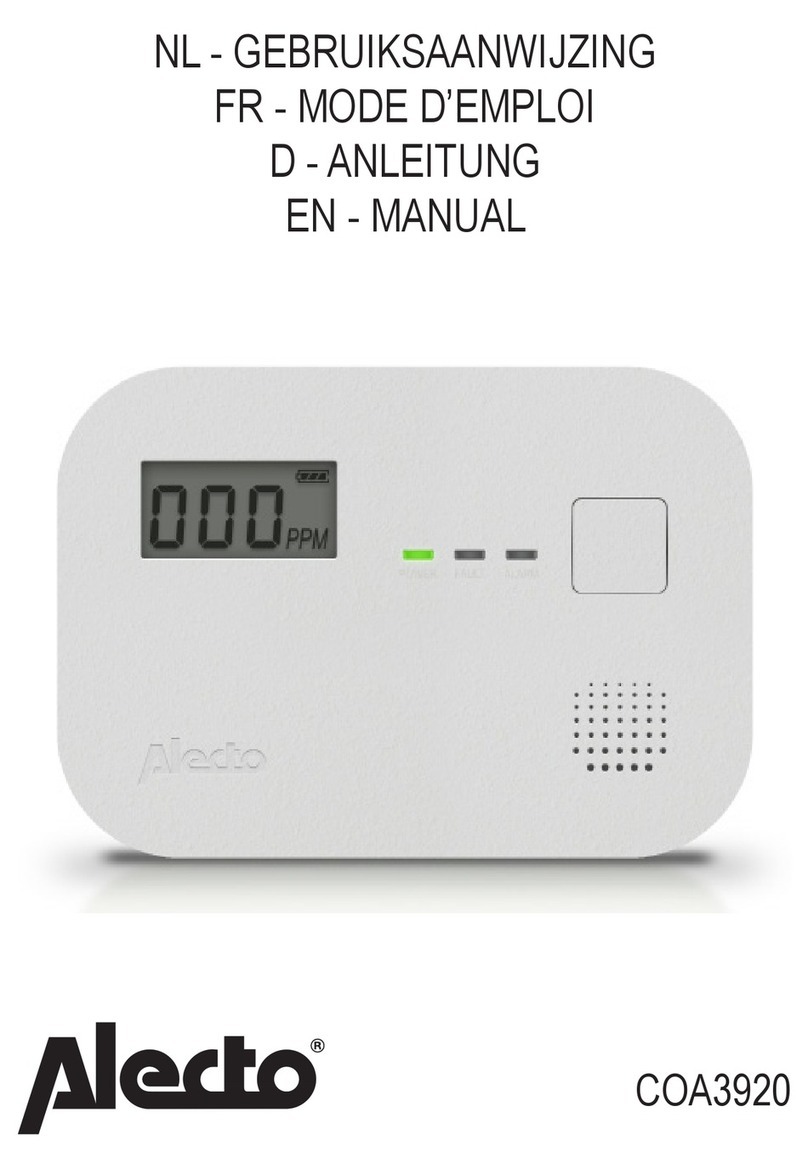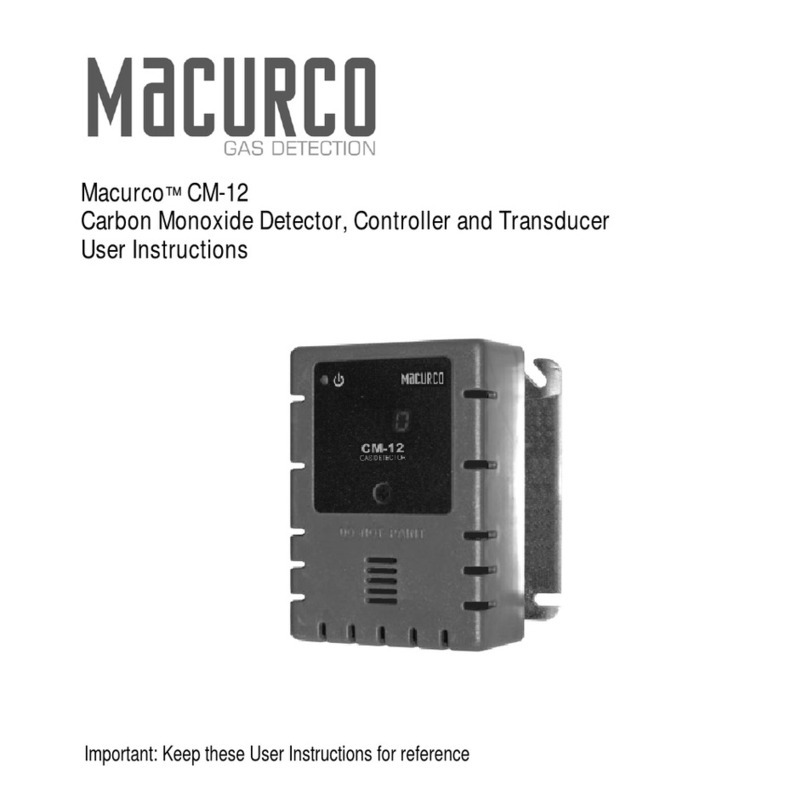GasTech G-Shield Fire User manual

G-Shield Instruction Manual
Version 12
1 Introduction
The G-Shield Fire is a gas detection system that attaches to a vehicle. It has a Human
Machine Interface (HMI), two Sensor Platforms, and two G-Pods. One G-Pod detects
Hydrogen Cyanide (HCN) and the other detects Carbon Monoxide (CO).
Figure 1. G-Shield Fire HMI shown in optional enclosure with two Sensor Platforms and a G-Pod.
2 Method of Operation
The HMI, Sensor Platforms, and G-Pods communicate by MODBUS RTU over RS-485.
This design allows multiple G-Pods to communicate with a single HMI. The G-Shield
Fire is configured for two G-Pods.
3 For Your Safety
WARNING: You must obey the instructions for the safe installation, use, and
maintenance of this equipment.
4 Further Information
Please tell us if you want help with this equipment.
Head Oce: Gastech, 24 Baretta Road, Wangara, WA 6065, Australia.
Note: Modification of this equipment is strictly prohibited without written permission
from Gastech Australia Pty Ltd.

G-Shield Instruction Manual
Version 13
Table of Contents
Introduction . . . . . . . . . . . . . . . . . . . . . . .
Method of Operation . . . . . . . . . . . . . . . . . . . .
For Your Safety . . . . . . . . . . . . . . . . . . . . . .
Further Information . . . . . . . . . . . . . . . . . . . . .
List of Figures . . . . . . . . . . . . . . . . . . . . . . .
Keywords and Symbols Used in This Manual . . . . . . . . . . . .
Intended use . . . . . . . . . . . . . . . . . . . . . . .
Safety Precautions . . . . . . . . . . . . . . . . . . . . .
What is in the Box? . . . . . . . . . . . . . . . . . . . . .
. HMI . . . . . . . . . . . . . . . . . . . . . . . . .
. Sensor Platform. . . . . . . . . . . . . . . . . . . . .
. G-Pod . . . . . . . . . . . . . . . . . . . . . . . .
Installation Information . . . . . . . . . . . . . . . . . . .
. HMI Installation . . . . . . . . . . . . . . . . . . . .
. Sensor Platform Installation . . . . . . . . . . . . . . . .
. G-Pod Installation . . . . . . . . . . . . . . . . . . .
Electrical Installation . . . . . . . . . . . . . . . . . . . .
. HMI Power Inputs . . . . . . . . . . . . . . . . . . .
. Sensor Platform Connections. . . . . . . . . . . . . . . .
. Sensor Platform Termination Resistor . . . . . . . . . . . . .
. Relay Connections . . . . . . . . . . . . . . . . . . .
. Wiring Diagram . . . . . . . . . . . . . . . . . . . .
. Cable Information . . . . . . . . . . . . . . . . . . .
HMI Operation . . . . . . . . . . . . . . . . . . . . . .
. HMI Power On. . . . . . . . . . . . . . . . . . . . .
. Information . . . . . . . . . . . . . . . . . . . . . .
. Settings . . . . . . . . . . . . . . . . . . . . . . .
. Incorrect PIN . . . . . . . . . . . . . . . . . . . . .
. Change PIN . . . . . . . . . . . . . . . . . . . . .
. Test Relays . . . . . . . . . . . . . . . . . . . . . .
. Gas Alarms - Alarm Levels. . . . . . . . . . . . . . . . .
. Gas Alarms - No Active Alarms . . . . . . . . . . . . . . .
. Gas Alarms - Warning Alarm Active. . . . . . . . . . . . . .
. Gas Alarms - Danger Alarm Active . . . . . . . . . . . . .
. Gas Alarms - Mutable Alarms . . . . . . . . . . . . . . .

G-Shield Instruction Manual
Version 14
Calibration . . . . . . . . . . . . . . . . . . . . . . .
. Calibration Reminder . . . . . . . . . . . . . . . . . .
. Response Test. . . . . . . . . . . . . . . . . . . . .
. HCN G-Pod Response Test . . . . . . . . . . . . . . . .
. CO G-Pod Response Test . . . . . . . . . . . . . . . . .
. HCN G-Pod Zero Calibration . . . . . . . . . . . . . . . .
. HCN G-Pod Span Calibration . . . . . . . . . . . . . . . .
. CO G-Pod Zero Calibration . . . . . . . . . . . . . . . .
. CO G-Pod Span Calibration . . . . . . . . . . . . . . . .
. Cancel Calibration . . . . . . . . . . . . . . . . . . .
. Calibration Due . . . . . . . . . . . . . . . . . . . .
Error Messages . . . . . . . . . . . . . . . . . . . . . .
. Communications Error . . . . . . . . . . . . . . . . . .
Specifications . . . . . . . . . . . . . . . . . . . . . .
. Electrical . . . . . . . . . . . . . . . . . . . . . .
. Construction . . . . . . . . . . . . . . . . . . . . .
. Environmental . . . . . . . . . . . . . . . . . . . . .
. G-Pod Dimensions . . . . . . . . . . . . . . . . . . .
. Sensor Platform Dimensions . . . . . . . . . . . . . . . .
. HMI Dimensions . . . . . . . . . . . . . . . . . . . .
. HMI Enclosure Dimensions . . . . . . . . . . . . . . . .
Spare Parts List . . . . . . . . . . . . . . . . . . . . . .
Maintenance . . . . . . . . . . . . . . . . . . . . . . .
. Clean the Splash Guard . . . . . . . . . . . . . . . . .
. Dummy Plug . . . . . . . . . . . . . . . . . . . . .
Gastech Policy Statements . . . . . . . . . . . . . . . . . .

G-Shield Instruction Manual
Version 15
5 List of Figures
Figure . G-Shield Fire HMI shown in optional enclosure with two Sensor Platforms and a G-Pod.
Figure . Keywords and symbols used in this manual.
Figure . The G-Shield Fire HMI.
Figure . The G-Shield Fire HMI fitted to its optional enclosure.
Figure . Sensor Platform with G-Pod fitted.
Figure . The G-Pod has electrical connections and an alignment key.
Figure . G-Shield HMI dashboard cutout.
Figure . G-Shield Fire HMI enclosure rear view showing VESA mounts.
Figure . Sensor platform exploded view.
Figure . Splash Guard.
Figure . G-Pod key and Sensor Platform keyway.
Figure . Bushing Nut with Grub screw.
Figure . HMI electrical connections.
Figure . Input power connection details.
Figure . Sensor Platform connection details.
Figure . SW set to the ON position on Sensor Platform .
Figure . Relay connection details.
Figure . Relay connection details.
Figure . G-Shield Fire system wiring diagram.
Figure . HMI user interface icons.
Figure . HMI home screen user interface.
Figure . HMI Power on.
Figure . HMI Power on after power interruption.
Figure . Alarm levels.
Figure . Home screen - no gas detected.
Figure . HCN Warning Alarm On.
Figure . CO Warning Alarm On.
Figure . HCN Danger Alarm On.
Figure . Push to mute Danger Alarm.
Figure . CO Danger Alarm On
Figure . Co Danger Alarm muted.
Figure . Calibration equipment.
Figure . Calibration reminder.
Figure . Calibrate now.
Figure . Response test gas requirements and pass criteria.
Figure . HCN response test too high.
Figure . HCN response test too low.
Figure . CO response test too high.
Figure . CO response test too low.
Figure . Sensor calibration due.
Figure . Error messages.
Figure . Sensor communication error.
Figure . G-Pod dimensions.
Figure . Sensor Platform dimensions.
Figure . HMI dimensions.
Figure . HMI enclosure dimensions.
Figure . List of spare parts.
Figure . HMI enclosure assembly.
Figure . Sensor Platform assembly.
Figure . Dummy Plug fitted to Sensor Platform.

G-Shield Instruction Manual
Version 16
6 Keywords and Symbols Used in This Manual
Symbol Keyword Description
Warning WARNING: Do not (warning text). Can cause injury or
death to personnel.
No
Symbol Caution CAUTION: Do not (caution text). Can cause damage
to parts or equipment.
HMI Human Machine Interface
(Shown with optional stainless steel enclosure).
Sensor Platform Sensor Platform with Splash Guard attached.
G-Pod G-Pod sensor module.
Splash Guard The Splash Guard gives protection to the G-Pod
from changes in environmental conditions.
Dummy Plug The Dummy Plug gives protection to the Sensor
Platform when a G-Pod is not fitted.
MODBUS MODBUS® is a data communications protocol
developed by Modicon now Schneider Electric.
7 Intended use
The G-Shield Fire detects HCN and CO outside the vehicle and displays the results on
the HMI.
WARNING: The G-Shield Fire detects HCN and CO. These gases can cause injury or
death to personnel.
WARNING: The G-Shield Fire is not a personal gas detector. If you do not use a
personal gas detector this can cause injury or death to personnel.
Figure 2. Keywords and symbols used in this manual.
WARNING: Do not use the G-Shield Fire in an explosive or oxygen rich atmosphere.
An explosion can cause injury or death to personnel.

G-Shield Instruction Manual
Version 17
8 Safety Precautions
Read all safety warnings before you install or operate this equipment.
9 What is in the Box?
The HMI has a touch panel display with connections for power, communications, and
external alarms. An RS-485 data port connects the HMI to the Sensor Platforms. Refer
to section 11, Electrical Installation.
Figure 3. The G-Shield Fire HMI.
The G-Shield Fire is available with an enclosure. Use the enclosure when it is not
possible to install the HMI directly into the dashboard. The enclosure is compliant with
the VESA 75 requirements.
9.1 HMI
Figure 4. The G-Shield Fire HMI fitted to its optional enclosure.

G-Shield Instruction Manual
Version 18
9.2 Sensor Platform
The Sensor Platform supplies the electrical connections for the G-Pods. The Sensor
Platform uses RS-485 and MODBUS RTU.
Figure 5. Sensor Platform with G-Pod fitted.
9.3 G-Pod
The G-Pod is a smart, hot-swappable gas detector that contains calibration
information and sensor data.
Calibrate the G-Pod in the workshop or maintenance section for fast deployment.
The G-Shield Fire is supplied with one HCN G-Pod, and one CO G-Pod.
Figure 6. The G-Pod has electrical connections and an alignment key.

G-Shield Instruction Manual
Version 19
10 Installation Information
WARNING: The G-Shield must be installed by an approved person. Incorrect
installation can cause injury or death to personnel.
10.1 HMI Installation
Install the HMI into the vehicle cab. You can install it directly into the dashboard or use
the optional stainless steel enclosure. The enclosure has an industry standard VESA
75 attachment on its rear cover.
WARNING: The HMI can distract the driver and cause an accident. An accident can
cause injury or death to personnel.
Figure 7. G-Shield HMI dashboard cutout.
Figure 8. G-Shield Fire HMI enclosure rear view showing VESA 75 mounts.

G-Shield Instruction Manual
Version 110
Figure 9. Sensor platform exploded view.
Install the Sensor Platforms vertically at the rear of the vehicle. Make sure the G-Pod
sinter faces the ground. Use the M25 x 1.5P thread to attach the Sensor Platform to the
vehicle. Torque the Mounting Nut to between 12Nm and 20Nm. Gastech recommends
finger tight and ⁄ of one turn. You can use Loctite® 243™ Threadlocker to make sure
the nut does not loosen because of vibration.
CAUTION: The G-Pod sinter must face towards the ground. Sudden pressure changes can
cause a loss of accuracy.
Replace the G-Pod with a Dummy Plug (P/N 65-2000-00) during maintenance. Refer to
section 17.2.
CAUTION: Do not try to attach the Splash Guard when a Dummy Plug is installed as it will not
fit.
10.2 Sensor Platform Installation
Make sure a Splash Guard is used when a G-Pod is attached to the Sensor Platform.
The Splash Guard provides protection to the G-Pod from wind and water.
Figure 10. Splash Guard.
CAUTION: Do not exceed 20Nm when the Mounting Nut is tightened. Damage can be caused
to the gasket.

G-Shield Instruction Manual
Version 111
10.3 G-Pod Installation
Align the key on the G-Pod with the keyway on the Sensor Platform. Push the G-Pod
into the Sensor Platform.
CAUTION: Sensor Platforms are supplied without a G-Pod installed. Make sure you install a
G-Pod.
The Bushing Nut attaches the G-Pod to the Sensor Platform. Hold the Bushing Nut in
position with the Grub screw. Tighten the Grub screw with the supplied 1.3 mm hex
wrench. Do not use thread lock.
NOTE: You will notice some resistance as air is expelled from between the G-Pod and
the Sensor Platform. This is normal.
CAUTION: Do not overtighten the Grub screw. The Grub screw can damage the threads on
the Sensor Platform.
Figure 11. G-Pod key and Sensor Platform keyway.
Figure 12. Bushing Nut with Grub screw.

G-Shield Instruction Manual
Version 112
11 Electrical Installation
Connect the G-Shield Fire to a DC supply voltage of 9 to 30V. The G-Shield Fire can
be installed into vehicles with a 12V DC or 24V DC electrical system.
Figure 13. HMI electrical connections.
The HMI has 2 inputs for power.
VBAT supplies constant power to the Sensor Platforms. VBAT connects internally
to VOUT+ on the sensor RS-485 connection. Constant power is necessary for the
G-Pods. Connect the vehicle battery input to VBAT.
ACC supplies power to the HMI. Connect the vehicle accessories circuit to ACC. The
HMI will turn on and o with the vehicle ignition.
11.1 HMI Power Inputs
Label Connection Description Rating
VBAT Positive supply from vehicle battery 9 - 30 VDC
GND GND connection
ACC Positive supply from vehicle accessories circuit 9 - 30 VDC
Figure 14. Input power connection details.
WARNING: The G-Shield must be installed by an approved person. Incorrect
installation can cause injury or death to personnel.

G-Shield Instruction Manual
Version 113
Label Connection Description
VOUT+ Positive supply voltage to Sensor Platform
A+ Signal A
B- Signal B
GND GND supply voltage to Sensor Platform
Figure 15. Sensor Platform connection details.
Label Connection description
NO Normally open relay contact
COM Common relay contact
NC Normally closed relay contact
Label Connector description
NO Normally open relay contact
COM Common relay contact
NC Normally closed relay contact
Figure 16. SW1 set to the ON position on Sensor Platform 2.
Figure 17. Relay 1 connection details.
11.2 Sensor Platform Connections
The HMI has 2 relay outputs to connect external equipment. The relays are activated
when the gas detected reaches the danger alarm level. See section 12.6 Test Relays.
RS-485 is a balanced transmission standard. The end of the electrical transmission
line must have a termination resistor. Set the switch SW1 to the ON position to use the
built-in termination resistor for Sensor Platform 2.
Figure 18. Relay 2 connection details.
11.3 Sensor Platform Termination Resistor
11.4 Relay Connections

G-Shield Instruction Manual
Version 114
11.5 Wiring Diagram
Figure 19. G-Shield Fire system wiring diagram.
11.6 Cable Information
Use four core sheathed cable between the HMI and the Sensor Platforms. The
maximum cable length permitted is 20m.
Use stranded tinned copper conductors in a PVC jacket. Cable size of 16 AWG to
22 AWG is suitable. The maximum allowable outside diameter (OD) is 6.5mm. Use
insulated bootlace ferrules to avoid damage to the copper conductors.
NOTE: You can use equivalent alternatives for this item.
The G-Shield Fire has two Sensor Platforms. Use a suitable cable to connect the HMI
to the first Sensor Platform and use the same specification cable to connect to the
second Sensor Platform. Refer to section 11.6 Cable Information.
Gastech recommends inline fuses for both power feeds. Refer to figure 19 for the fuse
values.
NOTE: The vehicle may already have adequate fuse protection.

G-Shield Instruction Manual
Version 115
12 HMI Operation
The HMI controls the G-Shield. It shows gas level, Sensor Platform status, and alarm
indication. The HMI has a capacitive touchscreen interface and uses custom icons and
text to give information to the user.
Figure 20. HMI user interface icons.
Figure 21. HMI home screen user interface.
Icon Description Icon Description
Back button Enter button
Home button Information button
Save button Settings button
Undo button

G-Shield Instruction Manual
Version 116
12.1 HMI Power On
The vehicles accessory circuit provides power to the HMI. When the vehicles ignition
is switched to ACC the HMI will turn on.
NOTE: Constant power is supplied to the Sensor Platforms through the VBAT
connection on the HMI.
Power applied to
HMI
Splash screen
G-Shield power
up completed
NOTE: The G-Shield is ready for use within one minute.
G-Shield is
ready for use
Power interruptions to the G-Pods require an additional warm up period. Interruptions
can be caused by routine maintenance to the vehicles electrical system or from failure
of the electrical system.
G-Pod power interruptions occur when VBAT is disconnected or when a G-Pod is
replaced.
Figure 22. HMI Power on.

G-Shield Instruction Manual
Version 117
The G-Shield follows an extended power up sequence when power is first applied to
the G-Pods.
Power applied to
HMI
G-Shield waits
for G-Pods to
stabilize
Sensor
Platforms
detected
Splash screen
G-Shield is
ready for use
G-Shield power
up completed
The G-Shield is prepared for use when the G-Pods complete their five minute
warm-up.
Figure 23. HMI Power on after power interruption.

G-Shield Instruction Manual
Version 118
12.2 Information
The information screen shows details of the installed sensors, the HMI firmware
version, and the telephone number for tech support.
The HMI home screen provides access to important system information.
Step 1. Push for three seconds. Step 2. Push to return to the home screen.
12.3 Settings
The settings menu is protected by a Personal Identification Number (PIN) code and is
accessed from the home screen.
Step 1. Push for three seconds. Step 2. Default PIN code is four zeros.
Step 3. Type in the PIN code. Push Step 4. Push to return to the home screen.
If the PIN code is not recognized please refer to section 12.4 Incorrect PIN.
NOTE: PIN codes can be four to six digits long. Each character is masked for security
purposes.

G-Shield Instruction Manual
Version 119
12.4 Incorrect PIN
The user has typed an incorrect PIN code. This example shows seven digits have
been entered. PIN codes must be four to six digits in length.
The HMI gives instant feedback if an incorrect PIN is entered. The input field is
automatically cleared and a message is displayed.
NOTE: There is no limit to the amount of times an incorrect PIN can be entered.
Contact Gastech if you have forgotten the PIN code.
Step 1. Push to continue Step 2. Type in PIN again.
12.5 Change PIN
Step 2. Type in the current PIN code.Step 1. Push to continue
Step 3. Push to continue. Step 4. Type in a new PIN code.

G-Shield Instruction Manual
Version 120
Step 5. Push to continue. Step 6. Type in the same new PIN code.
Step 7. Push to continue. Step 8. The PIN code has been changed.
If the PIN codes do not match, the HMI will display this screen.
NOTE: There are no limits to the number of times you can attempt to key in the new
PIN code.
If you cannot recall the new PIN code chosen, then push to start the change PIN
code operation again.
To stop the PIN code change, push until the Settings screen is shown. Push
to return to the home screen.
Step 9. Type in the same new PIN code.
Table of contents
Other GasTech Gas Detector manuals
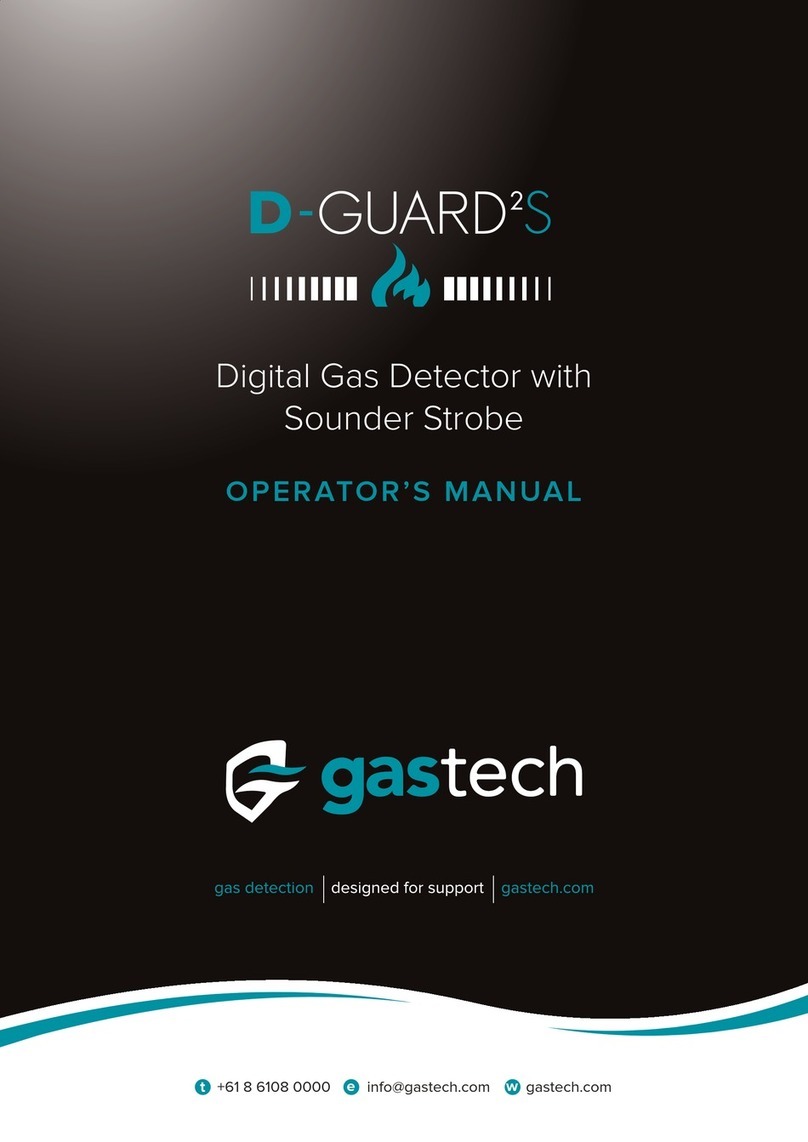
GasTech
GasTech D-Guard2S User manual

GasTech
GasTech F-GUARD UVIR User manual
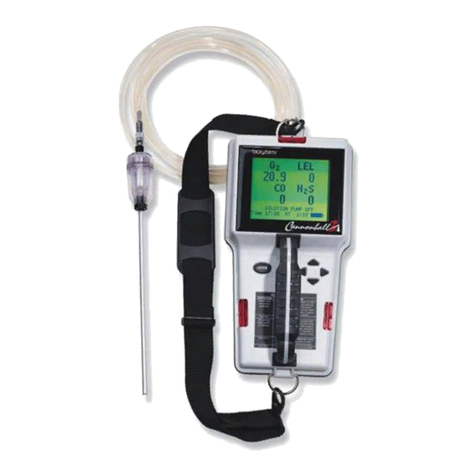
GasTech
GasTech Cannonball 3 User manual
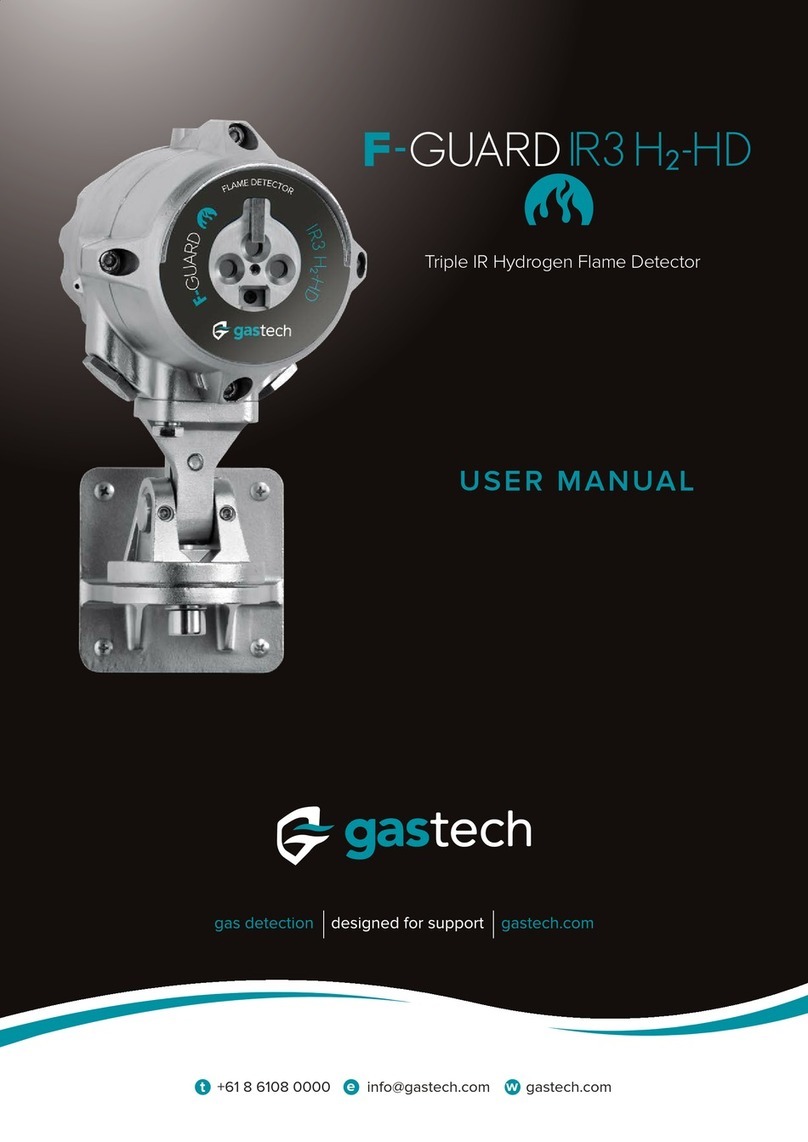
GasTech
GasTech F-Guard-IR3-H2-HD User manual
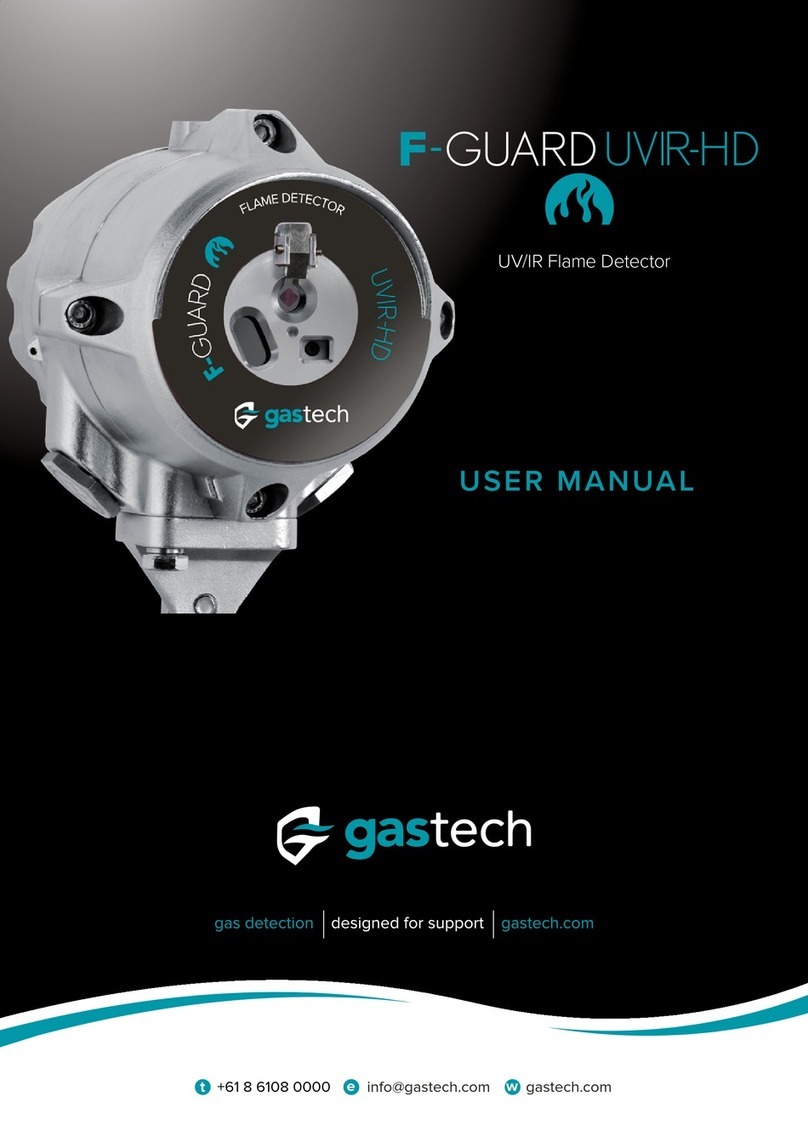
GasTech
GasTech F-Guard-UV-IR-HD User manual
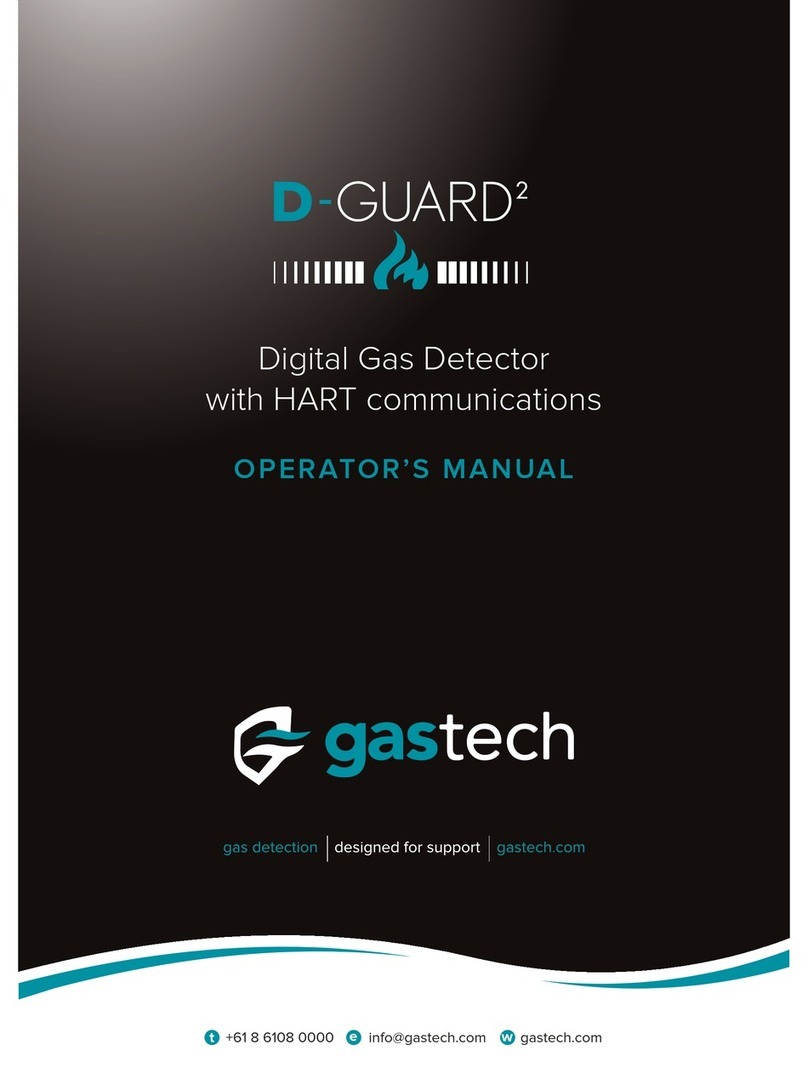
GasTech
GasTech D-Guard2 User manual
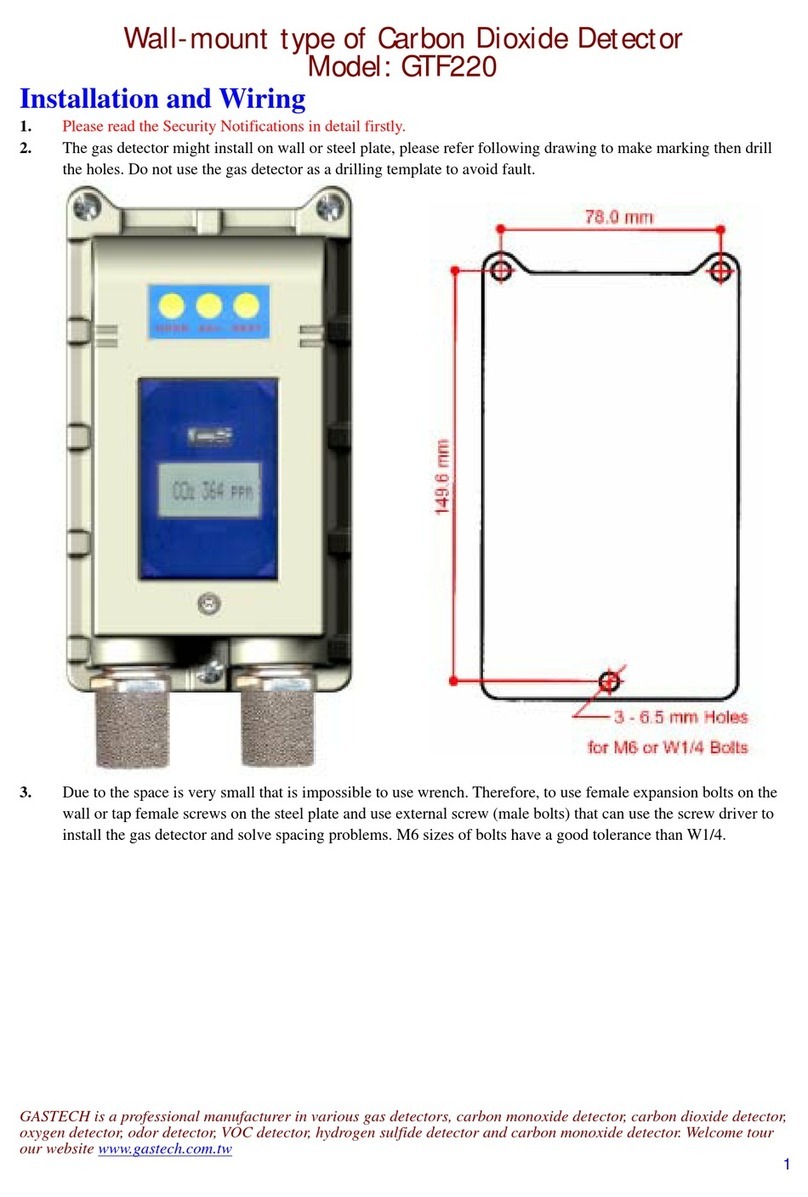
GasTech
GasTech GTF220 User manual
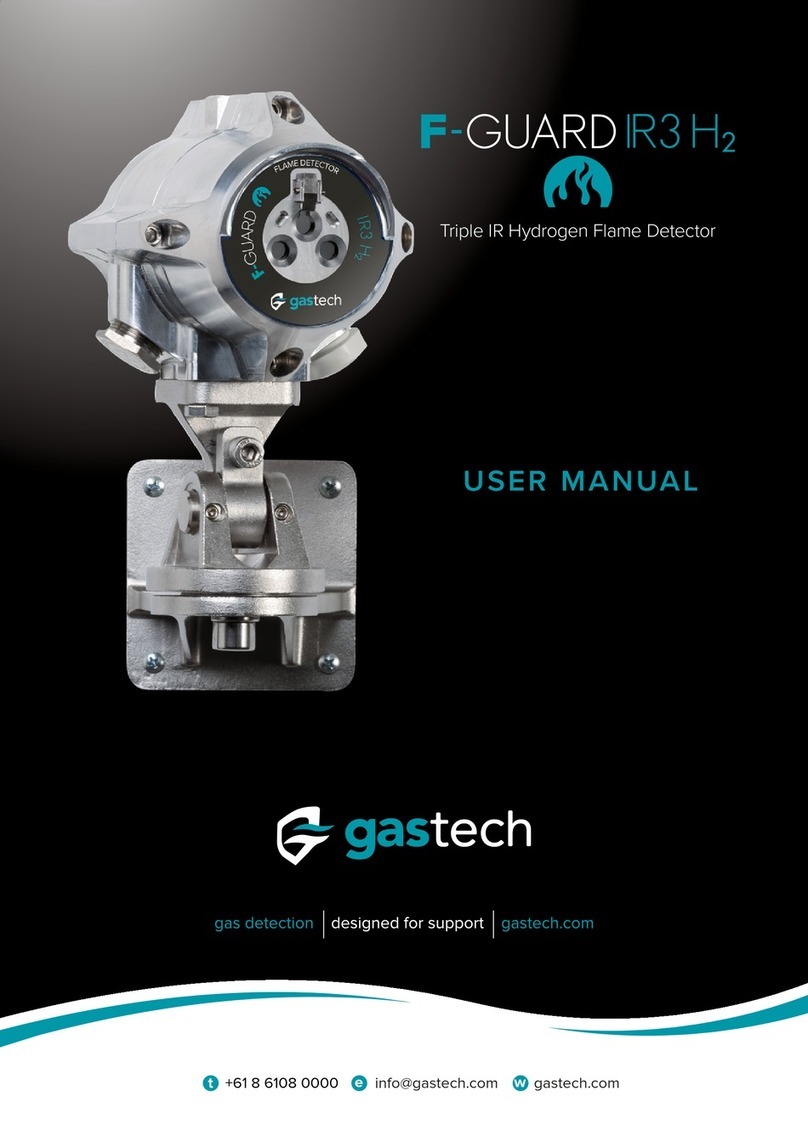
GasTech
GasTech F-Guard-IR3-H2 User manual
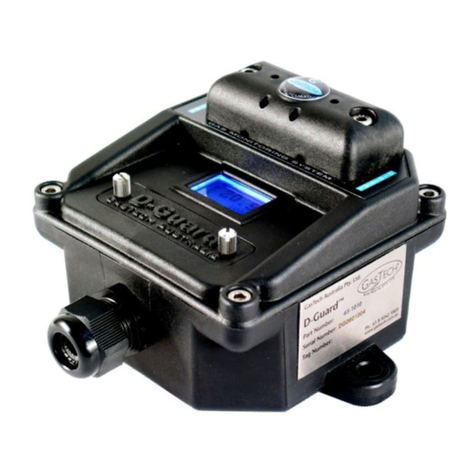
GasTech
GasTech D-Guard User manual
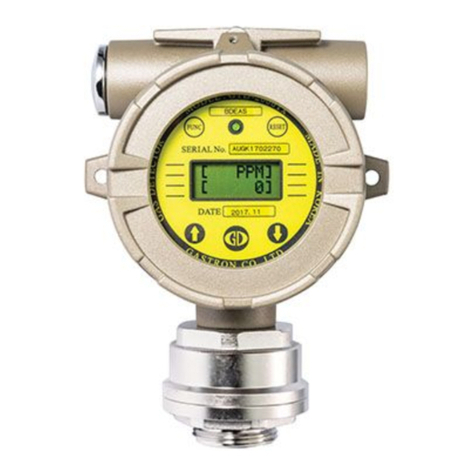
GasTech
GasTech GTD2000-Tx User manual


